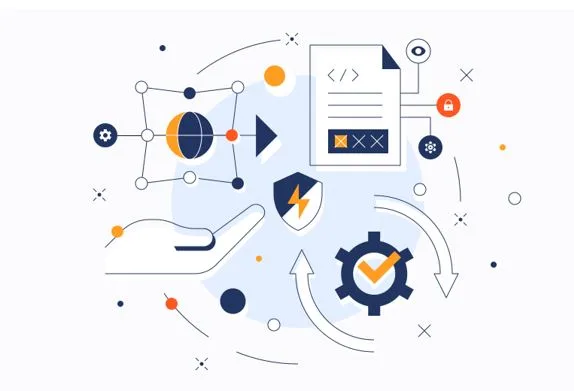No-Code Web Development: Revolutionizing Enterprise Digital Transformation in 2025
Introduction: The New Digital Landscape
Picture this: A marketing director builds a complex customer portal over a weekend. An operations manager creates a sophisticated inventory tracking system during their lunch break. A HR specialist designs an entire employee onboarding platform without writing a single line of code. This isn’t science fiction—this is the reality of no-code web development in 2025, and it’s fundamentally changing how enterprises approach digital transformation.
No-code development represents a paradigm shift in software creation, enabling non-technical users to build powerful applications through intuitive visual interfaces. What began as simple drag-and-drop website builder has evolved into sophisticated platforms capable of creating complex enterprise-grade solutions. For businesses today, this isn’t just about convenience—it’s about survival in an increasingly competitive digital ecosystem.
The statistics speak volumes: Reports indicate that the global market for low-code no-code development platforms is valued at nearly $15 billion and is expected to quadruple in the next five years . Even more compelling? Compared to full-scale IT modernization, which can take one to two years, no-code tools save 70% on costs, with set-up times as quick as three days .
In this comprehensive guide, we’ll explore how no-code platforms are revolutionizing enterprise web development, why this transformation matters for your business, and how partnering with a certified Webflow agency like Webyansh can position your organization at the forefront of this digital revolution.
The Enterprise Shift to No-Code: More Than Just a Trend
Why Enterprises Are Embracing No-Code
The adoption of no-code development in enterprise settings isn’t just following the latest tech trend—it’s a strategic response to critical business challenges. Traditional development approaches often create significant bottlenecks, with IT departments struggling to keep pace with departmental needs. The projected global shortfall of 4 million software developers by 2025 has only accelerated this transition .
Enterprises are discovering that no-code platforms offer compelling solutions to these pressing issues:
- Unprecedented agility: Departments can create solutions tailored to their specific needs without waiting for IT support, dramatically improving business agility
- Cost efficiency: Reducing development costs and minimizing errors leads to rapid ROI—achieving in weeks what traditionally took months
- Democratized innovation: Around 60% of relatively simple applications are now being developed by non-technical users, showcasing the potential of no-code platforms to democratize app development
The Citizen Developer Revolution
A profound shift happening in enterprises is the rise of the citizen developer—non-technical employees empowered to create applications using no-code platforms. This movement represents a fundamental change in how technology gets built within organizations.
Gartner predicts that by 2026, developers outside traditional IT departments will make up 80% of users of low-code development tools . This isn’t about replacing professional developers but about extending development capabilities throughout the organization, creating a more collaborative and innovative environment.
Table: Traditional vs. No-Code Development Approaches
| Factor | Traditional Development | No-Code Development |
| Timeline | Months to years | Weeks to months |
| Cost | High upfront investment | 70% cost savings |
| Required Skills | Specialized coding knowledge | Visual design thinking |
| Flexibility | Difficult to modify | Rapid iteration |
| Maintenance | Ongoing technical support | Simplified updates |
The Powerful Capabilities of Modern No-Code Platforms
Beyond Basic Builders: Advanced Features
Today’s no-code platforms have evolved far beyond simple website builders. The best no-code website builders in 2025 offer sophisticated capabilities that rival traditional development:
- AI-assisted development: Platforms now provide intelligent recommendations and automate routine tasks, speeding up development while ensuring applications are optimized for performance and usability
- Robust integration capabilities: Most platforms offer extensive integrations with popular software and APIs, allowing users to connect their no-code applications with existing tools seamlessly
- Enterprise-grade security: With built-in security features like user authentication, data encryption, and compliance tools, modern platforms meet strict enterprise requirements
- Advanced workflows: Drag-and-drop tools for creating intricate workflows and automating repetitive tasks with sophisticated logic
Table: Key Features of Enterprise No-Code Platforms
| Feature Category | Specific Capabilities | Business Benefit |
| Design & Interface | Drag-and-drop editors, pre-built components, responsive design | Rapid prototyping, consistent branding |
| Integration | API connections, third-party service integration, webhooks | Connected ecosystems, automated workflows |
| Data Management | Built-in databases, external data sources, CMS capabilities | Centralized information, real-time insights |
| Security | User authentication, role-based permissions, compliance certifications | Data protection, regulatory adherence |
| Scalability | Performance optimization, load balancing, modular architecture | Growth accommodation, reliability |
Leading Platforms for Enterprise No-Code Development
While numerous no-code platforms exist, several stand out for enterprise applications in 2025:
- Webflow: Stands out as one of the best no-code website builders due to its intuitive visual design interface, allowing users to create responsive websites without writing code. Its powerful features include a built-in CMS for dynamic content management, complex interactions and animations support, seamless e-commerce functionality, and robust SEO tools . Webflow offers unparalleled design freedom while generating clean, production-ready code.
- Bubble: Provides a visual programming language that allows users to build applications without code, while still offering advanced customization options for those who need it . This makes Bubble an excellent choice for businesses looking to create tailored web applications quickly.
No-Code Web Design Trends Shaping 2025
Creating Cutting-Edge Digital Experiences
Staying current with design trends is essential for maintaining competitive digital presence. In 2025, several key trends are emerging that no-code website developers can implement using modern platforms:
- Futuristic, sci-fi gaming UI aesthetics: Web designers are increasingly drawing inspiration from gaming interfaces, integrating 3D, intricate UI details and detailed microinteractions to create an atmosphere of high-tech immersion . This manifests through layered visual elements that simulate advanced digital environments, featuring translucent panels and interactive components that respond with cinematic fluidity.
- Sophisticated animated scrolls: The evolution of scrolling techniques has transformed how users interact with digital content, turning mundane navigation into dynamic storytelling experiences . Designers are building advanced scrolls to create experiences that respond dynamically to user movement: revealing content, triggering animations, and creating multi-layered visual narratives.
- Glow effects and light blooms: Designers are embracing luminous aesthetics that include sophisticated glows and light blooms . This approach transforms designs into vibrant, almost ethereal experiences that create depth, emphasize interaction, and introduce a sense of dynamic energy.
- AI-generated imagery: The use of AI-generated visuals and imagery is catching on in web design, with applications ranging from prototyping and creative exploration to production-ready imagery . This represents a significant shift in how visual content is conceptualized and created.
These trends demonstrate how no-code websites can deliver cutting-edge experiences that rival custom-coded solutions, all while maintaining faster development cycles and lower costs.
Implementing No-Code Solutions: A Strategic Approach
Your Roadmap to No-Code Success
Adopting no-code web development requires more than just selecting a platform—it demands a strategic approach to ensure optimal outcomes:
- Assess your needs comprehensively
Begin by identifying specific pain points and opportunities across departments. Evaluate which processes could benefit from custom applications and prioritize based on impact and feasibility.
- Select the right platform
Choose a platform that aligns with your technical requirements, integration needs, and security standards. Consider factors like scalability, compliance, and available expertise.
- Build a center of excellence
Establish a dedicated team or partner with a specialized Webflow agency like Webyansh to ensure best practices, maintain quality standards, and drive adoption.
- Start with pilot projects
Begin with manageable projects that deliver quick wins, demonstrate value, and build organizational confidence in no-code capabilities.
- Scale and expand strategically
Use lessons from initial projects to inform broader implementation, developing repeatable processes and patterns for future initiatives.
Overcoming Implementation Challenges
While no-code platforms offer tremendous benefits, enterprises may encounter specific challenges:
- Integration complexity: While most platforms offer robust integration capabilities, challenges can arise if a platform doesn’t support all the tools an organization uses . Careful evaluation of integration requirements is essential during platform selection.
- Security and compliance: As no-code platforms allow a wider range of employees to develop applications, there is a higher potential for security vulnerabilities due to the lack of traditional programming oversight . Implementing proper governance and involving IT experts early mitigates these risks.
- Skill development: Despite their accessibility, no-code platforms still require specific expertise to leverage their full potential. As one analysis notes, “You’ll still need to be proficient in web design and development basics (and even advanced practices) to be able to create a powerful site” .
These challenges aren’t barriers but rather considerations that inform a thoughtful implementation strategy, often making partnership with an experienced agency the most efficient path to success.
Why Choose Webyansh for Your No-Code Web Development
Your Partner in Digital Transformation
At Webyansh, a certified Webflow agency based in India, we don’t just build websites—we craft digital experiences that drive business growth. Our expertise spans the entire spectrum of no-code web development, from initial strategy to design, development, and ongoing optimization.
What sets us apart in the crowded landscape of no-code website developers?
- Deep platform expertise: As certified Webflow experts, we possess comprehensive knowledge of the platform’s capabilities, enabling us to create solutions that leverage its full potential while avoiding common pitfalls.
- Enterprise-grade solutions: We understand the unique requirements of enterprise clients, including scalability, security, and integration needs, ensuring our solutions perform reliably as your business grows.
- Holistic approach: Our services encompass expert UX/UI design, web development, and SEO, creating comprehensive digital presences that not only look impressive but deliver measurable business results.
- Dedicated partnership: We view ourselves as an extension of your team, committed to understanding your business objectives and delivering solutions that align with your strategic goals.
Our Proven Process
Our approach to no-code website development follows a methodology refined through numerous successful engagements:
- Discovery and strategy: We dive deep into your business objectives, audience needs, and technical requirements to develop a comprehensive digital strategy.
- Design and prototyping: Our design team creates intuitive, visually stunning interfaces that reflect your brand while optimizing user experience.
- Development and integration: We build your solution using Webflow’s powerful capabilities while seamlessly integrating with your existing systems and workflows.
- Testing and quality assurance: We conduct rigorous testing across devices and scenarios to ensure flawless performance and user experience.
- Launch and optimization: We manage the deployment process and provide ongoing support and optimization to ensure your digital presence continues to deliver value.
The Future of No-Code in Enterprise
Emerging Trends and Innovations
The evolution of no-code development continues at an accelerated pace, with several emerging trends set to further transform enterprise web development:
- AI integration becomes standard: Artificial intelligence is now deeply embedded in no-code platforms, suggesting layouts and features based on app type, automating content creation, personalizing user experiences, and providing predictive analytics on app performance .
- Mobile-first design dominance: With the majority of digital activity happening on smartphones, mobile-first is now the default approach for app design . This means optimized UI/UX for smaller screens, fast-loading lightweight apps, and gesture-based navigation support.
- Cross-platform output expansion: Users expect apps to be available everywhere, and no-code platforms increasingly support Android and iOS publishing from a single project, Progressive Web Apps (PWAs) for browser-based use, and cloud syncing across devices .
- Industry-specific templates: While general-purpose builders still exist, the trend is toward industry-specific templates that provide pre-built structures for ecommerce, learning apps, lifestyle apps, and community platforms .
These advancements will make no-code platforms even more powerful and accessible, further solidifying their position as essential enterprise tools.
Conclusion: Embrace the No-Code Revolution
The transformation of enterprise web development through no-code platforms represents one of the most significant shifts in digital strategy in recent years. These tools have evolved from simple website builders to sophisticated platforms capable of creating complex, enterprise-grade solutions that drive real business value.
The benefits are undeniable: unprecedented agility, substantial cost savings, democratized innovation, and the ability to bridge the growing technical skills gap. Enterprises that embrace no-code development position themselves to outperform competitors, respond more quickly to market changes, and empower their teams to create solutions that address specific business challenges.
As you consider your organization’s digital strategy for 2025 and beyond, ask yourself: Can we afford to maintain traditional development approaches that are increasingly slow, expensive, and constrained by resource limitations? Or is it time to embrace the future of web development?
The no-code revolution isn’t coming—it’s already here. The question is whether your organization will lead or follow.
Frequently Asked Questions About No-Code Web Development
1. What exactly is no-code web development?
No-code web development refers to creating software applications without writing traditional code. Instead, users leverage visual development environments with drag-and-drop interfaces, pre-built components, and intuitive design tools. This approach democratizes app creation, making it accessible to non-technical users while still enabling the creation of sophisticated, professional applications .
2. How does no-code differ from traditional development?
Traditional development requires writing code in programming languages, specialized technical skills, and extended development timelines. No-code development uses visual tools that significantly reduce technical barriers and development time. While traditional development offers unlimited customization, no-code platforms provide accelerated development, lower costs, and accessibility to non-technical users while still offering substantial customization capabilities .
3. Are no-code platforms secure enough for enterprise use?
Yes, modern no-code platforms implement robust security measures including user authentication, data encryption, role-based permissions, and compliance with standards like SOC 2 and HIPAA. However, proper governance is essential. Organizations should implement security best practices and involve IT experts in the development process to ensure enterprise security standards are maintained .
4. Can no-code websites integrate with our existing systems?
Absolutely. Most no-code platforms provide extensive integration capabilities through APIs, webhooks, and native connectors to popular business systems. This allows seamless connectivity with CRM platforms, marketing automation tools, payment gateways, and custom databases, enabling no-code applications to function as integrated components of your technology ecosystem .
5. What are the limitations of no-code development?
While increasingly powerful, no-code platforms may have constraints for highly specialized or computationally intensive applications. Extremely complex business logic or unique requirements beyond platform capabilities might require traditional development. However, for the vast majority of enterprise web development needs, modern no-code platforms offer more than sufficient capability and flexibility .
6. How does no-code support mobile responsiveness?
All major no-code website builders automatically create mobile-responsive designs that adapt seamlessly to different screen sizes. Most platforms use responsive grid systems, flexible layouts, and mobile-specific preview modes to ensure websites provide optimal viewing experiences across devices, from desktops to smartphones .
7. Why should we choose Webflow specifically for our enterprise website?
Webflow stands out for enterprise applications due to its unparalleled design flexibility, robust CMS capabilities, and production-ready code output. Unlike simpler template-based builders, Webflow offers granular design control while maintaining visual development benefits. Its powerful interactions, animations, and scalability make it ideal for enterprises seeking custom-quality designs with no-code efficiency







